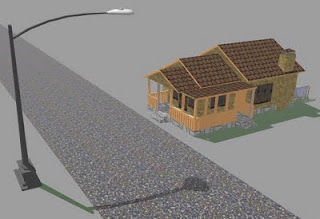The relationship of shapes to The Five Energies. The energietic qualities of shapes can have a marked effect on the lives of the people who live and work inside them. For example, your experience of sitting in a round room is very different to the feeling you have when seated in a square room. Similarly, you react ot a room with a high curved ceiling in one way and in another way to a room with a sloping roof. The effect of shapes - not only on your feelings but on the general direction of your life - is part of the storehouse of Feng Shui wisdom. One example of this effect is connected with roofs. But The shape of a building or a plot of land has significance as well. The contours affect the relationship of the enclosed space with the energy of the space that surrounds it. Some shapes attract energy to certain points in the structure, others repel it. Using this principle, it is possible to determine the most suitable points to locate yourself within the space. The incoming energy may be helpful or harmful to you - this depends on many factors; but the general principle in Feng Shui is that it is better to avoid you be subjected to the sustained impact of negative influences.
A house needs a clear sighline, just as a person needs to be able to see straight a head without obstruction. A level roof corresponds to a person whose cap is straight. Having a sloping roof over your head is like having the visor of your cap pulled down over your eyes. In Feng Shui, the family that lives in a house with a sloping roof will never advance, and a nation whose people live under such roofs will become inward-looking and stagnant.
An L-shaped house
Energy converges on a L-shaped house. If the front door is there, accidents will happen and many other things will go wrong. If you are looking at flats in a block shaped like this, your best bet is to choose one at either of the ends, shown in a lighter tone, for away from the converging arrows.
Concave and convex curves
A curved surface that is concave acts like a receiver. It draws energy toward itself. If you were to build a house on land with this shape, the safest locations would be at the two ends, with the entrance facing in toward the middle. An outward, convex curve deflects the energy: even those beams that strike the middle fail to penetrate. Any location inside such a space is relatively protected.
An L-shaped house
Energy converges on a L-shaped house. If the front door is there, accidents will happen and many other things will go wrong. If you are looking at flats in a block shaped like this, your best bet is to choose one at either of the ends, shown in a lighter tone, for away from the converging arrows.
Concave and convex curves
A curved surface that is concave acts like a receiver. It draws energy toward itself. If you were to build a house on land with this shape, the safest locations would be at the two ends, with the entrance facing in toward the middle. An outward, convex curve deflects the energy: even those beams that strike the middle fail to penetrate. Any location inside such a space is relatively protected.


















































